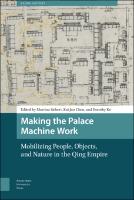Making the Palace Machine Work
Mobilizing People, Objects, and Nature in the Qing Empire
Contributor(s)
Siebert, Martina (editor)
Jun Chen, Kai (editor)
Ko, Dorothy (editor)
Siebert, Martina (editor)
Chen, Kai Jun (editor)
Ko, Dorothy (editor)
Language
EnglishAbstract
This volume brings the studies of institutions, labour, and material cultures to bear on the history of science and technology by tracing the workings of the Imperial Household Department (Neiwufu) in the Qing court and empire. An enormous apparatus that employed 22,000 men and women at its heyday, the Department operated a "machine" with myriad moving parts. The first part of the book portrays the people who kept it running, from technical experts to menial servants, and scrutinises the paper trails they left behind. Part two uncovers the working principles of the machine by following the production chains of some of its most splendid products: gilded statues, jade, porcelain, and textiles. Part three tackles the most complex task of all, managing living organisms in nature, including lotus plants grown in imperial ponds in Beijing, fresh medicines sourced from disparate regions, and tribute elephants from Southeast Asia.
Keywords
China, Qing Court, Material culture; Imperial Household DepartmentDOI
10.5117/9789463720359ISBN
9789048553228, 9789048553228Publisher
Amsterdam University PressPublisher website
https://www.aup.nl/Publication date and place
2021Imprint
Asian HistoryClassification
Museology and heritage studies
Asian history


 Download
Download Web Shop
Web Shop